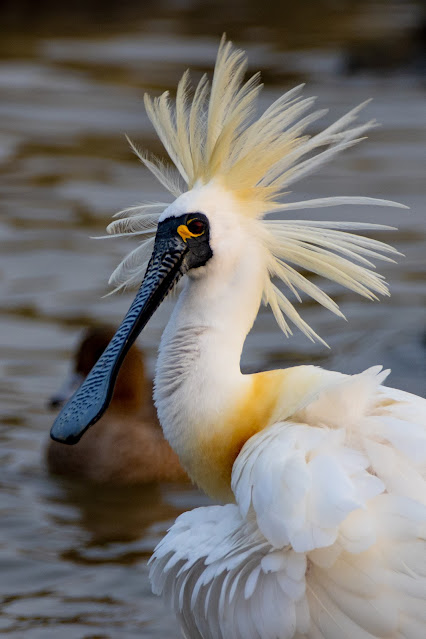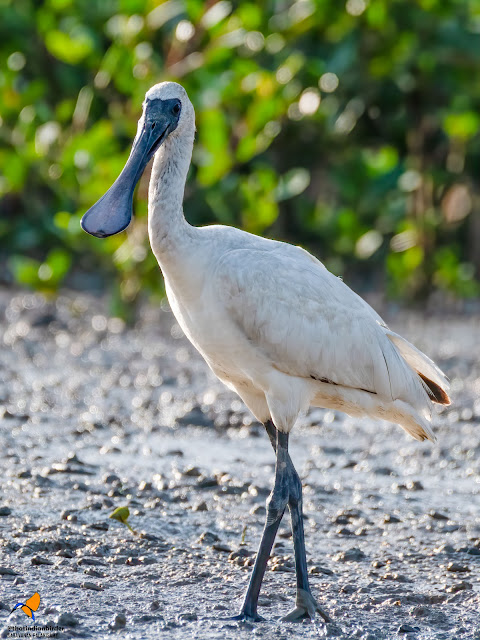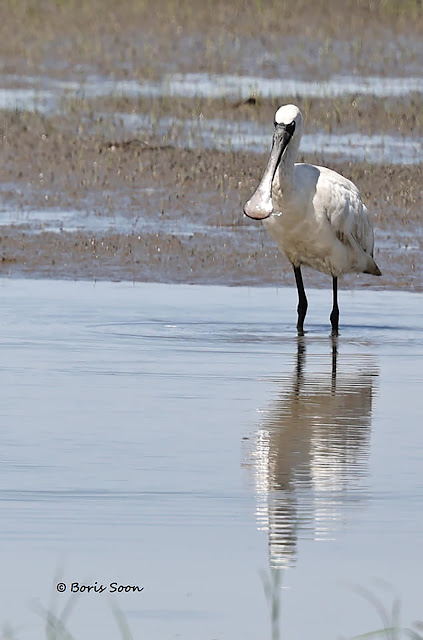Name: Black Faced Spoonbill
Other Name: Lesser Spoonbill
Scientific Name: Platalea minor
Local (Malay) Name: Sekendi Sudu Muka Hitam
Measurement: 60 - 78 cm
Black Faced Spoonbill is a species water bird belongs to the ibis and spoonbill family (Threskiornithidae). It has the most restricted distribution of all six species of spoonbills. As it name implies, it has a spatula shaped bill.
Description:
Non breeding adults are white with black facial skin, bill and legs. Breeding spoonbills have chest washed with yellow, as well as with yellow markings at its eyes and long plumes. Subadults looks alike the non breeding adults, however their primaries are tipped with black, which is visible during flight.
 |
| Black Faced Spoonbill in breeding plumage, from Shenzhen, Guangdong Province (China). Photo credits: Mengti Yang (Taiwan) |
 |
| Black Faced Spoonbill in breeding plumage, from Shenzhen, Guangdong Province (China). Photo credits: Mengti Yang (Taiwan) |
Status and Distribution:
Vagrant.
Black Faced Spoonbills are confined to the coastal region of East Asia. Breeds on the West coast of Korean Peninsular, Liaoning Province (China) and East coast of Khankha Lake (Russia). It winters (October to April) at Taiwan (Tsengwen Estuary), Hong Kong (Deep Bay), coastal area of South China, South Korea (Jeju), Japan, Vietnam, Cambodia, Thailand and the Philippines. It is considered as passing migrant at East coast of Korean Peninsular, Japan and coastal region of East China.
It was sighted on 19th November 2019 for the first time in Malaysia at North Central Selangor Coast, IBA MY011, by Ong Kang Woei, Chin Choong Liung, Low Kok Hen, Jacelyn See and Yeap Chin Aik during a boat survey. One individual (sub adult) observed flying towards South. It was distinguished as a Black Faced Spoonbill by comparing its leg projection during flight with other possible spoonbill species (Eurasian Spoonbill).
 |
| A sub-adult Black Faced Spoonbill sighted in 2019 at IBA MY011- First Record for Malaysia. Photo credits: Ong Kang Woei (UPM, Malaysia) |
It was later sighted for the second time on 15th December 2020 at Teluk Air Tawar - Kuala Muda Coast IBA MY003 by Dr Nur Munirah of Shorebirds Peninsular Malaysia Project. It was a sub adult spoonbill, seen feeding at Sungai Penaga tidal flats. The bird was last seen feeding at this spot on 29th Dec 2020 (morning). It was believed had flew away to other location. SPMP team tried to relocate the bird along the coast, yet the it was not seen again.
 |
| A sub-adult Black Faced Spoonbill from Teluk Air Tawar-Kuala Muda coast - 2nd record for Malaysia. |
Another individual was sighted at Kota Belud (Tempasuk rice field) on 6th Jan 2021 onward. It was seen feeding on freshwater shrimps.
 |
| 3rd sighting of Black Faced Spoonbill for Malaysia, from Tempasuk rice field (Kota Belud, Sabah). Photo credits: Boris Soon (Sabah) |
 |
| Black Faced Spoonbill (sub-adult), from Tempasuk rice field (Kota Belud, Sabah). Photo credits: Vui Kun (Sabah) |
 |
| Black Faced Spoonbill (sub-adult), from Tempasuk rice field (Kota Belud, Sabah). Photo credits: Vui Kun (Sabah) |
 |
| Black Faced Spoonbill (sub-adult), from Tempasuk rice field (Kota Belud, Sabah). Photo credits: Vui Kun (Sabah) |
There were 3 sightings recorded for spoonbills at Sabah in the 1960s (22nd Feb 1962 and 11th Sept 1968 - Papar, 12th Jan 1968 - Tempasuk), yet the actual species were unable to be determined and tagged as "Uncertain". It could be either a Black Faced Spoonbill or a Eurasian Spoonbill.
Confusion Species:
Both Eurasian Spoonbill (Platalea leucorodia leucorodia) and Black Faced Spoonbill are similar looking birds and also forage together. Eurasian Spoonbills can be distinguished from Black Faced Spoonbill by its yellow tipped black bill and the lack of black facial skin.
 |
| Eurasian Spoonbill (non breeding plumage) from Chambal River, Rajasthan, India. Photo credits: Sunil Singhal (Rajasthan, India) |
 |
| Eurasian Spoonbill (non breeding) from Kaohsiung, Taiwan. Photo credits: Mengti Yang (Taiwan) |
Geographical Variation:
None. Monotypic.
Behavior:
Forages in flock. It feed on fish, shrimps and large aquatic insects, that were caught by sweeping the partially opened bill in the turbid water preferentially during dawn and dusk. The bill will be opened wider if most preys are large. It was not clear on how the bird gauges the width of its opening; it could be the bird sensed or encountered larger prey, or by observing the prey size caught by other individuals.
Once the bill partially immersed in the water, the bird sweeps the bill in the water from side to side. The flatness of the mandibles minimizes the drag and turbulence while the bird sweep its bill looking for its prey. This reduces the chances of prey to get disturbed in advance and flee due to turbulence. Closer analysis of its bill revealed that there are numerous pits found on the tip of its mandibles. The pits are relatively more dense on the laterals and insides of the bill. These pits are most likely spaces for the sensory receptors. Therefore its bill construction explains well for its lateral feeding movements. Once the prey is captured, the bill is taken out from the water and prey is tossed and swallowed whole. From field observation, it do not raise its bill tip above the horizontal when it handles and swallows the prey.
Compared to storks, Black Faced Spoonbill's "sweepings" are observed to be much faster, probably due to the bill's structure and larger number of receptors. These receptors also enable the bird to hunt in turbid water and during night time, with minimal visual clues.
The bird advances with a step forward at the end of every sweeps. Steps are paused when prey is captured and handled for swallowing. The spoonbill also sweeps without stepping forward when the water is too deep to walk about and prey concentration is relatively high. The bottom structure of foraging area and occurrence of obstacles also hinder its move-about during feeding.
Habitat:
Tidal flats, estuaries, artificial wetlands and freshwater habitats (i.e. rice fields)
Breeding:
Breeds in colony along with other water birds (i. e. Grey Heron, cormorants and gulls). Male spoonbill will initiate the courtship by preening the female's cheek, head and neck. Female will respond with preening too. After few minutes, the male spoonbill will raise its plume and grasp the female's bill, then proceeds to copulate. The courtship and copulation will continue until the day before last egg is laid. Some birds tend to change their mate in different years. Nest is build with sticks; more sticks will be added during incubation and brooding. Male bird will bring the sticks and passes to the female where it places sticks on the nest. It also been observed to re-use old nest, including those old nests of other birds, i.e. Grey Heron nest.
Two to three eggs (white with small brown spots) are laid. Incubation period is approximately 26 days. Both male and female take turn to incubate the eggs. Eggs are turned in between incubation shifts. Night incubation is done by female bird itself.
Brooding period is about 40 days. The nestlings initially will have pointed bill tip, which turn into more rounded shape later. The spoon shaped bill appears in approximately 2 weeks time after hatched. The breeding plumage of the adults will disappear and plumes will shed about 30 days after the chicks hatched. Chicks will fledge in 40 days.
Hybrids:
Hybrids between a male Eurasian Spoonbill and a female Black Faced Spoonbill were recorded between year 2012-2015 at Incheon, South Korea. A total of 11 eggs were laid during these period, which produced 9 successful hybrid offspring. The hybrids had intermediate morphology between Black Faced and Eurasian Spoonbill; with larger body, longer bills and legs than Black Faced Spoonbills. Hybrids also lacks the black facial skin and have much smaller, paler yellow patch under its lower mandible. There is a variation in the portion of black markings on the facial skin among the hybrid individuals.
Conservation Status:
Classified as "Endangered" under IUCN Red List of Threatened Species. It is a totally protected species in its breeding regions. Its conservation actions was initiated in the 1990s where back then it was evaluated as "Critically Endangered" species globally. In the end of 1990s, the Black Faced Spoonbill had become one of the best known conservation stories in East Asia. In ten years, the effort really made a change in the local attitude to the conservation of this bird. Second conservation planning were initiated in 2005 in Japan, for those birds population in Russia, East coast of China and South Korea.
It was initially listed as "Threatened" species under World Checklist of Threatened Birds by International Council for Bird Preservation (now known as Birdlife International) in the late 1988. Six years later, it was listed as "Critically Endangered" in the revised edition as more details had been known regarding its population and threats at its wintering grounds. In the late 1990s, its status was re-evaluated since it could not meet the "Critically Endangered" criteria due to some increase in its population and reduction of its threats as well. Therefore the Black Faced Spoonbill was classified as "Endangered" after that and its status was remain unchanged till now.
Based on the International Black Faced Spoonbill Census done in 2021 by Hong Kong Bird Watching Society (HKBWS), 5222 wintering individuals had been recorded from Korean Peninsular, Japan, coastal area of China and Philippines.. This number show an increase (of 7%) in the population compared to year 2020 (4864 individuals recorded). However regionally, significant drop in the population had been recorded between 2020 and 2021 (Mainland China, Deep Bay area of Hong Kong and Shen Zen, Republic of Korea and the Philippines).
 |
| Population trend of Black Faced Spoonbill at wintering region. Source: International Black Faced Spoonbill Census 2021. |
Habitat loss and degradation is the greatest threat for the Black Faced Spoonbills throughout its range since tidal flats reclamation (for agriculture, aquaculture, industries and urban developments) is considered severe at both of its breeding and wintering grounds. This is further contributed by the high human population density and rapid economic growth of East Asian countries.
Pollution, which is contributed by industries and settlement adjacent to its habitat, is another threat for this species, since it reduces the available food source at the tidal flats. Hunting and egg collection also reduces its numbers in the wild. This species also disturbed by other human activities such as fishing, shellfish collection, bird watching and photography, especially at its breeding sites. According to a research done in 1999 at Xing Ren region of China revealed that shellfish collectors, photographers and powerboats are the major sources of disturbance causing the Black Faced Spoonbills to abandon its nests.
Since habitat loss and degradation contributes mostly to the population decline of this bird, important sites need to be identified and legally designated as protected areas or protected through proper land use planning and management at those sites. Proper enforcement also needed to reduce human interference at these protected areas to ensure successful breeding which may boost the its population.
References:
1. Ueta. M, Kurosawa. R and Allen. D (2000) Conservation and Research of Black Faced Spoonbills and Their Habitat, Wild Bird Society of Japan.
2. Swennen. Cornellis, Yu Y.T. (Jan, 2009) Food and Feeding Behavior of the Black Faced Spoonbill, Ecological Studies of Endangered Black Faced Spoonbill.
3. Yu Y.T, Li, C.H., Tse, I.W.L. and Fong, H.H.N. (2021) International Black Faced Spoonbill Census 2021, Black Faced Spoonbill Research Group, The Hong Kong Bird Watching Society & BirdLife International.
4. In-Ki Kwon, Ki-Sup Lee, Ji-Yeon Lee, Jong-Hyun Park and Jeong-Chil Yoo, Hybridization between the Black Faced Spoonbill (Platalea minor) and Eurasian Spoonbill (Platalea leucorodia) in South Korea, Waterbirds, 40(1), 77-81, (1 Mar 2017).
5. MNS Records Committee, https://sites.google.com/site/mnsbccrecordscommittee/Home/latest-news
Special Thanks for those who contribute photographs and information:
1. Dr Nur Munira, Shorebirds Peninsular Malaysia Project.
2. Dave Bakewell
3. Premala Arulampalam-Gehri & Adrian Gehri (Kota Kinabalu, Sabah)
4. Ong Kang Woei (UPM, Malaysia)
5. Sunil Singhal (Rajasthan, India)
6. Mengti Yang (Taiwan)
7. Boris Soon (Sabah)
8. Vui Kun (Sabah)



No comments:
Post a Comment